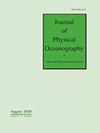Generation and Evolution of Internal Solitary Waves in a Coastal Plain Estuary
IF 3
2区 地球科学
Q1 OCEANOGRAPHY
引用次数: 0
Abstract
Large-amplitude internal solitary waves were recently observed in a coastal plain estuary and were hypothesized to evolve from an internal lee wave generated at the channel-shoal interface. To test this mechanism, a 3D nonhydrostatic model with nested domains and adaptive grids was used to investigate the generation of the internal solitary waves and their subsequent nonlinear evolution. A complex sequence of wave propagation and transformation was documented and interpreted using the nonlinear wave theory based on the Korteweg-de Vries equation. During the ebb tide a mode-2 internal lee wave is generated by the interaction between lateral flows and channel-shoal topography. This mode-2 lee wave subsequently propagates onto the shallow shoal and transforms into a mode-1 wave of elevation as strong mixing on the flood tide erases stratification in the bottom boundary layer and the lower branch of the mode-2 wave. The mode-1 wave of elevation evolves into an internal solitary wave due to nonlinear steepening and spatial changes in the wave phase speed. As the solitary wave of elevation continues to propagate over the shoaling bottom, the leading edge moves ahead as a rarefaction wave while the trailing edge steepens and disintegrates into a train of rank-ordered internal solitary waves, due to the combined effects of shoaling and dispersion. Strong turbulence in the bottom boundary layer dissipates wave energy and causes the eventual destruction of the solitary waves. In the meantime, the internal solitary waves can generate elevated shear and dissipation rate in local regions.沿海平原河口内部孤波的产生和演变
最近在沿海平原河口观测到大振幅内孤立波,并假设它是由海峡-浅滩界面产生的内背风波演变而来的。为了验证这一机制,使用了一个具有嵌套域和自适应网格的三维非流体静力模型来研究内孤立波的产生及其随后的非线性演变。用基于Korteweg-de Vries方程的非线性波动理论记录和解释了波的传播和转换的复杂序列。退潮时,侧流与河道滩地形相互作用产生2型内背风波。这种2型背风波随后传播到浅滩上,并在涨潮的强烈混合作用下消除了底边界层和2型波下分支的分层,从而转化为高程1型波。由于波相速度的非线性陡增和空间变化,高程1型波演变为内孤立波。当高程孤立波在浅滩底部继续传播时,由于浅滩和频散的共同作用,前缘以稀疏波的形式向前移动,而尾缘则变陡并解体为一列秩序内孤立波。底部边界层的强烈湍流耗散波能,导致孤波最终毁灭。同时,内孤立波会在局部区域产生较高的剪切速率和耗散速率。
本文章由计算机程序翻译,如有差异,请以英文原文为准。
求助全文
约1分钟内获得全文
求助全文
来源期刊
CiteScore
2.40
自引率
20.00%
发文量
200
审稿时长
4.5 months
期刊介绍:
The Journal of Physical Oceanography (JPO) (ISSN: 0022-3670; eISSN: 1520-0485) publishes research related to the physics of the ocean and to processes operating at its boundaries. Observational, theoretical, and modeling studies are all welcome, especially those that focus on elucidating specific physical processes. Papers that investigate interactions with other components of the Earth system (e.g., ocean–atmosphere, physical–biological, and physical–chemical interactions) as well as studies of other fluid systems (e.g., lakes and laboratory tanks) are also invited, as long as their focus is on understanding the ocean or its role in the Earth system.

 求助内容:
求助内容: 应助结果提醒方式:
应助结果提醒方式:


